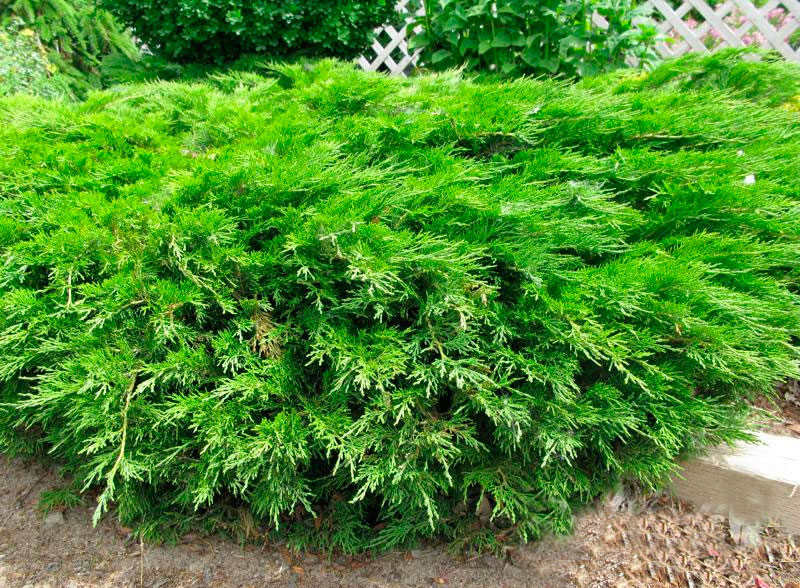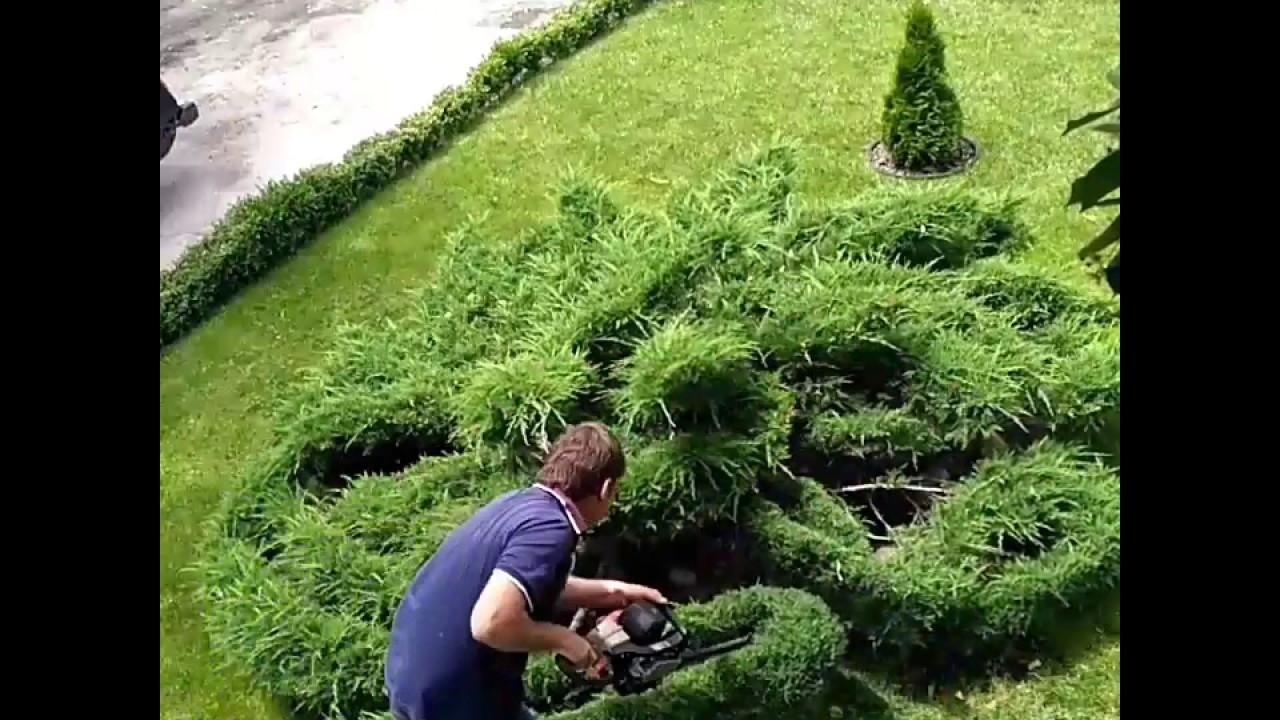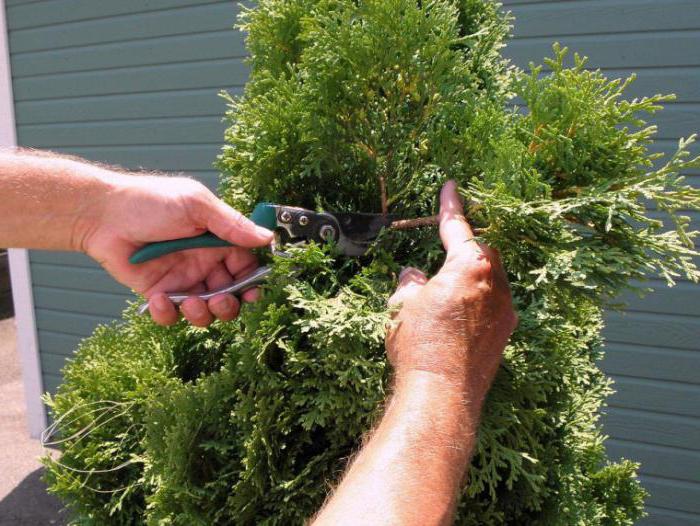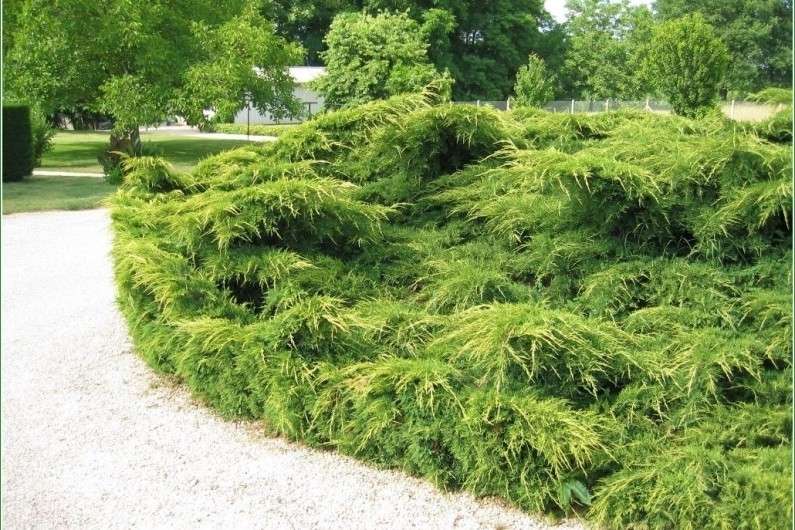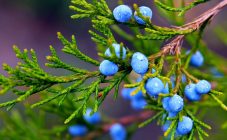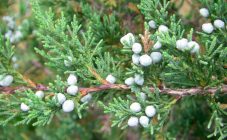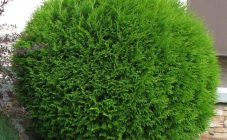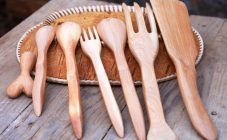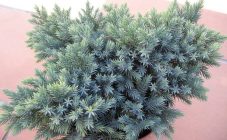Content:
Recently, one of the favorite plants for home cultivation has become a juniper, which easily survives formation. Gardeners consider its main advantages to be ease of care and maintenance, as well as the resistance of the culture to drought and cold. Grows easily in various soil mixtures, even the poorest. The juniper bush is often used to create a hedge in home gardens. Further in the article about the peculiarities of the culture, what is the proper care, how the juniper pruning is carried out and when.
Description of culture, growth features
Juniper in some sources may be called heres, is a representative of the cypress genus. It is the second most popular shrub, after cypress. It is known that the common coniferous bush gained popularity due to its features:
- Some species may have a prickly deciduous part, while striking with unusual external beauty;
- In others, thin, obedient shoots are struck, which can not only spread in different directions. Often, various shapes can be formed from them. At the same time, cutting a juniper is a simple process.
Plants are also valued for their ease of reproduction, because there are several ways, with a focus on different preferences. Everyone can determine for themselves a simple and effective way of reproduction, which will allow for successful production of a culture.
There are tree-like bushes with a lush pyramidal or cone-like crown.
The culture differs in the presence of unisexual flowers:
- Women's - appear as greenish bumps;
- For men - they look like earrings with 3 or 4 stamens.
Summer is a period for flowering, it usually begins in early June. Fruiting begins in August and ends in September. Juniper fruits - cones berries, are often used in folk medicine. In nature, culture grows in the forest parts of the northern regions. But this does not interfere with growing plants in suburban areas. Moreover, the bushes delight with their decorative effect, an interesting coniferous smell and healing properties.
Pruning Cossack juniper
Juniper is a coniferous crop, the care of which is not difficult. All that is needed is to weed and loosen the soil, water and spray the bushes in hot weather, and also periodically trim. Most gardeners are interested in how to prune a juniper, what is needed for this, and when such actions are correct to carry out.
Focusing on what shape of the crown should be obtained, the following methods are distinguished by which pruning is carried out:
- Spot - this method involves shaping the shoots, cutting them to formed buds. This method helps to form bushes for the first time when the juniper has few more branches.Varieties that growers would like to leave a natural creeping look can be trimmed in the same way. For this, the selected shoots are cut above the bud, about 2-3 cm, with an incision at an angle of 45 degrees;
- Blind - pruning Cossack juniper in this way involves cutting off almost all young branches using a garden tool. When such a "hairstyle" is done for plants, there is no need to become attached to the location of the buds or anything else. It is so good to arrange a living fence from a culture, it is suitable for bushes with dense, well-developed crowns.
It is best, knowing how to trim juniper, choose cloudy days for the procedure. It is important that this is a cool period, for example, autumn. Additionally, before cutting, it is recommended to spray the bushes using sprinkling. Moistened coniferous branches are much easier to cut, and garden tools are not dull.
Formative circumcision
One of the most important properties of conifers is fast branching. Therefore, the topiary method of care is aimed, first of all, at reducing the activity of shoot development in order to improve their natural decorative appearance.
Of the entire mass of branches, it is necessary to select only a few of those that are correctly located. The remaining coniferous mass must be cut out, leaving only the shoots growing at the top. Here's how to prune horizontal juniper, Cossack and rocky species to form a bush. Subsequent measures involve only the removal of young branches that appeared in the following seasons. In this case, it is allowed to remove no more than 25% of the increase in one season.
The common juniper variety does not need frequent haircuts. Superficial removal of young shoots is sufficient to increase the density of the crowns. It is recommended to cut hedges several times during the summer by shortening the branches sticking out of the fence. In a larger mass, the crop easily tolerates formation and pruning, but to reduce the recovery period, the plant is sprayed with growth stimulants.
When to prune a crop
Junipers, like other plants, are best pruned in the fall or when spring comes. In more detail, the best period is from September to October and from April to May. A feature of the plant is the easy tolerance of pruning, which allows such pruning to be carried out without reference to the period. The only exceptions are June and July, when shoots are actively developing at the peak of the juice movement. Also, you should not carry out such procedures in winter.
For juniper bushes, one pruning is enough, but if necessary, you can increase it up to twice a year. This applies to varieties that are fast-growing plants, from which they have already begun to form a figure. With the frame method of growing, plants can not be cut at all if they do not interfere.
Pruning in the fall
You can cut juniper bushes for the first time not earlier than in the second year after planting in open soil. During this time, the plant will be able to take root, get stronger and grow branches.Only then can you begin to form plants. Activities for the formation of bushes in the autumn can be continued until the first frost. But it is best to remove all unnecessary before the end of October, so that the plant has time to heal the cut areas and prepare for wintering.
To quickly and efficiently remove excess parts, you must use the following tools:
- Special scissors with long lightweight handles for cutting trees;
- Pruner - the easiest to use is a model with elongated blades, which can pick up shoots less than 2 centimeters. Large branches are trimmed with ratchet pruning shears;
- Lopper - specially designed scissors with a long handle. Such a tool is used to trim shoots in hard-to-reach places;
- Treatments - needed to protect cut areas from insects and sap loss.
The first step is to rid the bushes of dried out branches affected by pests and diseases. Also, young shoots that do not grow properly and create crown density are necessarily cut off. It should be borne in mind that the average growth of bushes is no more than 10 cm per year, which means that in the fall you can cut no more than 20% of what has increased over the year.
The first and basic rule by which specialists prune bushes is that it is better to cut a little less than to overdo it. It is necessary to remove sprout buds and shoot only after thinking well and calculating each action. Cutting off excess buds can provoke a complete inhibition of the growth and development of the culture.
Experts recommend using this scheme, removing branches in the fall:
- It is necessary to cut at an angle of 45 degrees to the kidneys. If you cut below the required level, the cut part on the tree will tighten for a long time. In addition, such actions can provoke abnormal development of the kidney, the result will be a low growth or death of shoots;
- Shoots growing upward are cut off, leaving at the end of the buds, which are located to the side of the center (called external). If the branchy part grows downward, pruning is done the other way around, leaving the internal buds;
- To remove branches, you should leave about 2 cm of stumps. It will be a kind of blockage for the upper buds from the dying part. So the kidney can grow and develop in the future.
Tips for forming a crown
To maximize the decorative properties of plants, it is not enough just to periodically remove the excess. Juniper, like other representatives of the coniferous culture, has certain requirements that affect its decorative properties:
- Correctly chosen location;
- Landing in fertile soil compositions;
- Properly organized ongoing care.
For the first time, you can start forming the crown only the next year after planting in open ground. Depending on the variety, this process can be delayed from one to three years after planting. In general, you can start forming the crown if the plant is strong, healthy in appearance and has a dense, fully formed leafy part.
The geometric shape of the plant must be determined based on the natural characteristics of the coniferous culture in general and specifically for the variety. For example, a pyramidal shape through trimming can be converted into a cone-shaped, ovoid, or left as a pyramid. Plants with a rounded and squat crown can be formed into a ball, cube or trapezoid.
You can trim juniper plants planted in your backyard, starting in early spring and continuing until mid-autumn. The only main condition is the average daily temperature, which should be at least 4 degrees above zero. Shaping haircuts must be carried out at least 2 times during the spring season:
- With the arrival of spring, when shoots are just beginning to grow;
- At the end of summer, prune young shoots to speed up their lignification and prepare the plant for the winter period.
Also, when starting the formation, you need to select the pruning period so that it does not coincide with the time of active growth and development of shoots. Autumn formations should be carried out while minimizing plant stress. At this time, it is better to let the plant thicken the crown a little. It is also imperative to remove bald shoots, the needles from which have already crumbled. Such branches do not have dormant buds and in the future cannot be covered with thorns. They only spoil the decorativeness of plants.
The best varieties for landscape design
Superiority among gardening art, incl. for curly haircuts of conifers, Europe possesses. In general, shade-tolerant plant species with limited growth are best preferred for decorative site decoration. The first characteristic helps to keep the crown in a uniform state. The limited and slow growth allows the number of circumcisions required to be reduced to a minimum.
Popular coniferous crops that lend themselves well to formation are:
- Thuja western;
- Cross-pair microbiota;
- Norway spruce;
- Juniper Chinese, Virginia, ordinary;
- Yew pointed;
- Lawson's cypress.
Summing up, it should be recalled that spring and autumn are considered the best time for pruning juniper shoots, it is possible to carry out the procedure in summer. At the same time, in central Russia, it is not recommended to prune in the second half of summer, since in this case the shrubs will not be able to fully prepare for the arrival of cold weather in time and in full. Cutting in autumn is recommended for the purpose of sanitizing the plant to remove dry, diseased and damaged branches.
